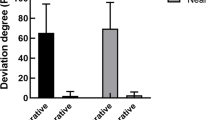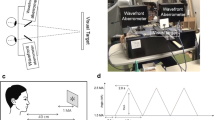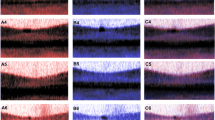Summary
Photorefraction and photokeratometry were performed on two juvenile tuatara (Sphenodon punctatus, 7 years of age, total length approx. 27 cm). Sphenodon is the only surviving genus of the Rhynchocephalia, an order of reptiles. Both existing species are endangered and are found only in New Zealand. Even though Walls (1942) has stated that the ciliary muscle is relatively weak in tuataras, we observed 8 D of accommodation. The eyes were found to focus independently and we could induce an anisometropia of 6 D. The average corneal power of the tuatara was found to be 101 D.
Similar content being viewed by others
References
Daugherty CH, Cree A, Hay JM, Thompson MB (1990) Neglected taxonomy and continuing extinctions of tuatara (Sphenodon). Nature 347:177–179
Glickstein M, Millodot M (1970) Retinoscopy and eye size. Science 168:605–612
Günther A (1867) Contribution to the anatomy of Hatteria (Rhynchocephalus, Owen). Phil Trans R Soc Lond 157:595–629
Howland HC (1985) Optics of photoretinoscopy: Results from ray tracing. Am J Optom Physiol Optics 62:621–625
Howland HC, Howland B (1974) Photorefraction, a technique for the study of refractive state at a distance. J Opt Soc Am 64:240–249
Howland HC, Sayles N (1984) Photorefractive measurements of astigmatism in infants and young children. Invest Ophthalmol Visual Sci 25:93–102
Ireland LC, Gans C (1977) Optokinetic behavior of the tuatara, Sphenodon punctatus. Herpetologica 33:339–344
Meyer-Rochow VB (1988) Behaviour of young tuatara (Sphenodon punctatus) in total darkness. Tuatara 30:36–38
Murphy CJ, Howland HC (1987) The optics of comparative ophthalmoscopy. Vision Res 27:599–607
Osawa G (1898) Beitrage zur Lehre von den Sinnesorganen der Hatteria punctata. Arch Mikrosk Anat Entwicklungsgesch 52:268–366
Robb J (1986) Tuatara. In: Halliday T, Adler K (eds) The Encyclopedia of reptiles and amphibians. Facts on File Inc, New York pp 134–135
Rochon-Duvigneaud A (1943) Les yeux et la vision des vertebrés. Masson et Cie., Paris
Saint-Girons H (1985) The Sphenodon: Ecological features and some hypotheses concerning its evolution. Bull Chicago Herpetol Soc 20:48–51
Schaeffel F, Farkas L, Howland HC (1987) Infrared photoretinoscope. Appl Optics 26:1505–1509
Schaeffel F, Howland HC (1987) Corneal accommodation in chick and pigeon. J Comp Physiol A 160:375–384
Troilo D, Wallman J (1987) Changes in corneal curvature during accommodation in chicks. Vision Res 27:241–247
Underwood G (1970) The eye. In: Gans C, Parsons TS (eds) Biology of the Reptilia. Academic Press, New York, pp 1–97
Walls GL (1942) The vertebrate eye and its adaptive radiation. Cranbrook Institute of Science, Bloomfield Hills, Michigan, pp 616–621
Author information
Authors and Affiliations
Rights and permissions
About this article
Cite this article
Schmid, K.L., Howland, H.C. & Howland, M. Focusing and accommodation in tuatara (Sphenodon punctatus) . J Comp Physiol A 170, 263–266 (1992). https://doi.org/10.1007/BF00191413
Accepted:
Issue Date:
DOI: https://doi.org/10.1007/BF00191413




